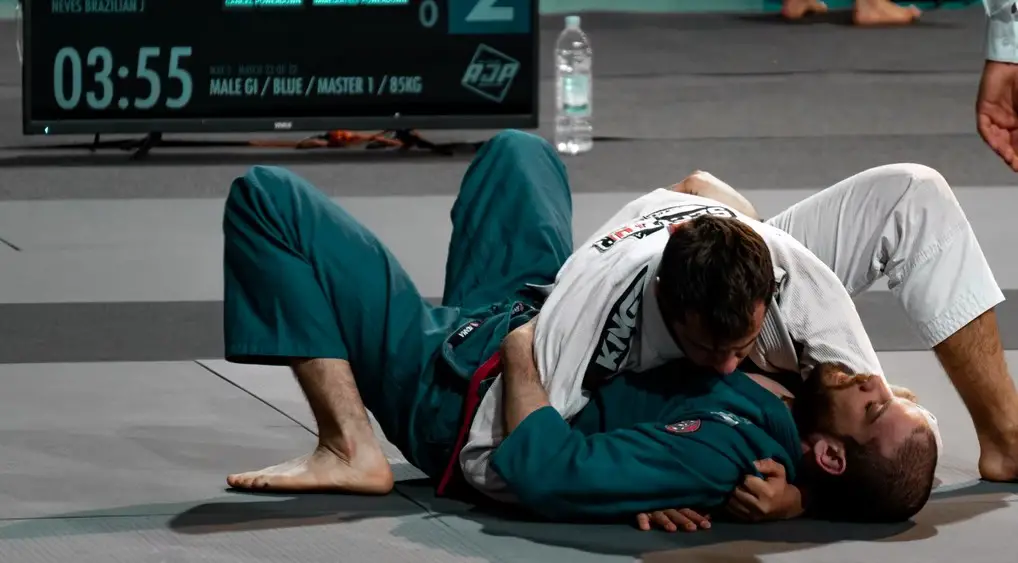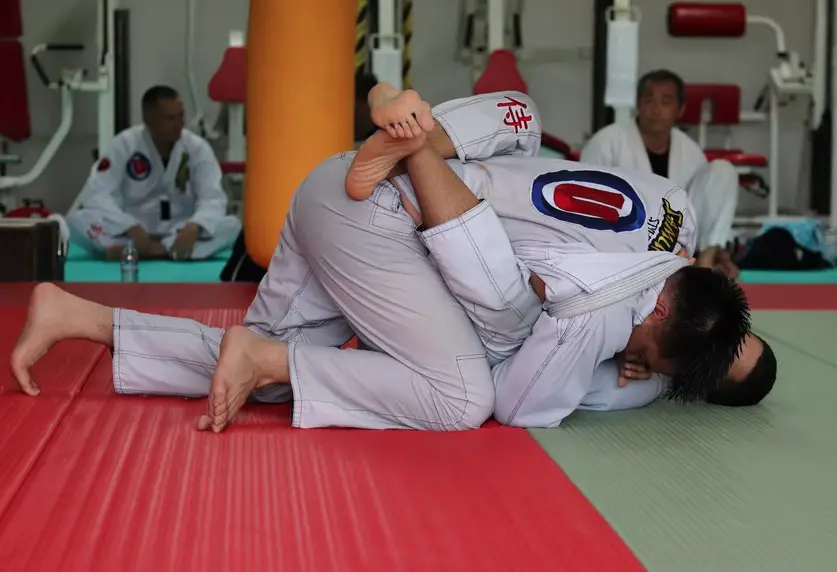When comparing Muay Thai and Brazilian Jiu-Jitsu (BJJ), examining how each martial art stands out in various aspects is essential.
Muay Thai is a striking art known as the "art of eight limbs," whereas Brazilian Jiu-Jitsu focuses on grappling and submission holds, designed to neutralise opponents on the ground. Each has unique benefits and strengths, but which is better?
Let's answer this question across different factors, from combat effectiveness to fitness benefits.
Let's get straight to the point
Choosing between Muay Thai and Brazilian Jiu-Jitsu (BJJ) depends on personal goals. Muay Thai focuses on striking ("art of eight limbs") and is effective in stand-up fighting with punches, kicks, elbows, and knees. It’s great for quick self-defence, cardio endurance, and full-body strength.
On the other hand, BJJ emphasises ground control and submissions, making it ideal for close-quarters combat with a focus on technique over power and strategic problem-solving.
A combination of both arts is essential for MMA, covering striking (Muay Thai) and ground control (BJJ). Cost-wise, Muay Thai is generally more affordable and accessible.
Both offer unique fitness and mental benefits; the right choice depends on whether you prefer stand-up or ground-based combat.
1. Combat Effectiveness: Stand-Up Vs. Ground Fighting

Combat effectiveness is a primary consideration when comparing martial arts. Muay Thai and BJJ excel in different areas:
Muay Thai - Stand-Up Superiority
- Primary Focus: Muay Thai emphasises stand-up fighting, using a combination of punches, kicks, elbows, and knees.
- Offensive Techniques: Strikes are intended to overwhelm the opponent, creating distance or dealing damage.
- Advantages:
- Versatile Striking: Fighters can strike from different ranges using hands, legs, knees, and elbows.
- Defensive Movements: Techniques include blocking and evading to protect against incoming attacks.
Brazilian Jiu-Jitsu - Ground Dominance
- Primary Focus: BJJ specialises in ground control and submissions, wallowing fighters to neutralise ground threats
- Control-Based Techniques: BJJ techniques focus on securing dominant positions and applying locks or chokes to force submission.
- Advantages:
- Effective in Close Combat: A BJJ practitioner can maintain control over an opponent once on the ground.
- Technique Over Power: Leverage and technique allow smaller fighters to subdue larger opponents.
Winner in Combat Effectiveness: Muay Thai has the advantage in stand-up confrontations, while BJJ is superior when fights go to the ground. In an MMA setting, combining both gives fighters a well-rounded skill set.
However, if limited to a single discipline, the choice depends on preference for stand-up (Muay Thai) or ground combat (BJJ).
2. Self-Defence Applications: Real-World Scenarios
Self-defence is another critical area where each martial art has unique advantages.
Muay Thai - Immediate Defence Skills
- Focus on Strikes: Muay Thai’s striking skills are highly effective. In a street fight or self-defence scenario
- Defensive Techniques: ThPushicks (tips), low kicks, and quick punches can keep an opponent at bay.
- Real-World Advantages:
- Rapid Response: Immediate counter-attacks can discourage or disable an aggressor.
- Distance Management: Push kicks and elbows help maintain control over distance.
Brazilian Jiu-Jitsu - Control And Restraint
- Focus on Restraint: BJJ provides techniques to subdue an opponent without causing significant harm.
- Ground Control: Techniques like the guard, rear-naked choke, and arm locks are effective in real-world scenarios.
- Real-World Advantages:
- Less Physical Damage: Practitioners can control or submit an attacker without striking.
- Useful in Confined Spaces: BJJ can be advantageous in areas where movement is restricted, like elevators or crowded spaces.
Winner in Self-Defence: Muay Thai may be more practical for quick self-defence due to its stand-up nature and ability to strike rapidly. BJJ is more suited for controlled confrontations, especially in confined spaces where ground control is advantageous.
Both are effective, but Muay Thai might offer an edge for street encounters where immediate response is essential.
3. Physical Fitness And Conditioning
Both martial arts contribute significantly to physical fitness but do so in distinct ways.
Muay Thai - Intense Cardio And Full-Body Strength
- Cardio-Intensive: Muay Thai training includes extensive cardio exercises and builds endurance and strength.
- Muscle Engagement: Striking techniques strengthen the legs, core, and upper body.
- Benefits:
- Increased Endurance: High-intensity sessions improve cardiovascular health.
- Full-Body Strength: Each strike engages multiple muscle groups, promoting balanced strength development.
Brazilian Jiu-Jitsu - Functional Strength And Flexibility
- Focus on Flexibility: BJJ relies on flexibility, especially in the hips, legs, and back.
- Core and Grip Strength: Techniques like holding positions or applying submissions build core and grip strength.
- Benefits:
- Functional Strength: Techniques rely on body weight and positioning, enhancing real-world strength.
- Improved Flexibility: Regular training improves range of motion, which benefits health and injury prevention.
Winner in Physical Fitness: Muay Thai offers intense cardio and builds full-body strength through striking, making it ideal for people seeking high-intensity workouts. BJJ provides functional strength and flexibility, which benefit long-term fitness and joint health.
Muay Thai is better for cardio, while BJJ is superior for functional strength and flexibility.
4. Mental Benefits And Strategy

Martial arts are also beneficial for mental well-being and developing strategic thinking.
Muay Thai - Mental Toughness And Reaction Time
- Aggressive Strategy: Muay Thai emphasises an aggressive but controlled approach, training practitioners to think and react quickly.
- Focus on Resilience: Training sessions challenge practitioners to push through pain and fatigue.
- Mental Benefits:
- Improved Reaction Time: Quick decision-making is essential in Muay Thai.
- Resilience and Toughness: Regular sparring and drills help develop mental strength.
Brazilian Jiu-Jitsu - Patience And Problem-Solving
- Strategic Approach: BJJ relies heavily on understanding moves, positioning, and anticipating opponents.
- Focus on Patience: Practitioners must remain calm and wait for openings to execute submissions.
- Mental Benefits:
- Problem-Solving Skills: Each technique requires careful thought and strategy.
- Increased Patience: BJJ teaches practitioners to wait for the right moment, promoting patience and control.
Winner in Mental Benefits: BJJ promotes patience, strategic thinking, and problem-solving, which can be valuable outside martial arts.
Muay Thai develops reaction time and resilience. Both have mental benefits, but BJJ focuses more on strategic thinking, while Muay Thai enhances mental toughness.
5. Learning Curve And Time Commitment
Learning a martial art requires time, patience, and consistent effort.
Muay Thai - Faster To Pick Up, Tough To Master
- Quick Start: Basics like punches and kicks can be learned quickly, making it accessible to beginners.
- Mastery Takes Time: Advanced techniques, endurance, and sparring skills require years of practice.
- Learning Curve:
- Accessible Basics: Striking techniques can be effective with minimal training.
- Long-Term Skill Development: Mastering combinations and defensive techniques requires commitment.
Brazilian Jiu-Jitsu - Slower Start, High Complexity
- Slow Progression: BJJ requires time to understand the fundamentals of positioning and submissions.
- High Complexity: Techniques are intricate, and advancement often takes years.
- Learning Curve:
- Patience Required: Learning positions, transitions, and submissions takes time.
- Significant Commitment: Progression from white to black belt is slower than other martial arts.
Winner in Learning Curve: Muay Thai is more accessible for beginners due to its straightforward techniques, though mastery still requires dedication. BJJ has a steeper learning curve but rewards practitioners with effective techniques as they progress.
Muay Thai is better for quick learning, while BJJ offers depth for those committed to long-term mastery.
6. Practicality In MMA

In mixed martial arts, fighters often need skills from both Muay Thai and BJJ to succeed.
Muay Thai - Essential Striking In MMA
- Key for Stand-Up Fights: Muay Thai skills are critical in MMA for maintaining distance and striking power.
- Combination of Techniques: Muay Thai kicks, elbows, and knees are highly effective in MMA competition.
- Advantages of MMA:
- Versatile Striking: Effective for controlling the pace and inflicting damage.
- Defensive Skills: Clinching skills help defend against takedowns and create space.
Brazilian Jiu-Jitsu - Essential For Ground Control
- Necessary Ground Skills: BJJ is essential for submissions and defence against ground attacks in MMA.
- Control and Submission: Fighters use BJJ to secure victories on the ground.
- Advantages of MMA:
- Submission Skills: Key to finishing fights when on the ground.
- Defensive Techniques: Helps prevent or escape from ground control positions.
Winner in MMA Practicality: Both are essential in MMA. Muay Thai provides powerful striking, while BJJ is invaluable for ground control and submissions. More than martial arts is required for MMA, as a combination of both is required for balanced skills.
7. Cost And Accessibility
Cost and accessibility are practical considerations for many people interested in martial arts.
Muay Thai - Generally More Accessible
- Widespread Availability: Muay Thai gyms and classes are available in many cities worldwide.
- Affordable Equipment: Basic gear like gloves and shin guards are relatively inexpensive.
- Cost Benefits:
- Lower Initial Costs: Starting Muay Thai is often more affordable.
- Wider Availability: Many gyms offer classes, making them accessible.
Brazilian Jiu-Jitsu - Often Higher Cost And Limited Access
- Specialised Training: BJJ requires qualified instructors, leading to higher costs.
- More Equipment: BJJ requires a gi (uniform), which adds to the cost.
- Cost Challenges:
- Higher Training Fees: BJJ classes can be more expensive than Muay Thai.
- Fewer Gyms: BJJ is less widely available in certain regions.
Winner in Cost and Accessibility: Muay Thai is more accessible and affordable, making it a practical choice for beginners. BJJ can be costlier and is less widely available in some areas.
Conclusion
The choice between Muay Thai and Brazilian Jiu-Jitsu (BJJ) depends on your goals and preferences. Muay Thai is ideal for those seeking powerful stand-up striking, intense cardio, and quick self-defence.
At the same time, BJJ excels in ground control, submissions, and strategic problem-solving, making it effective in controlled, close-quarter situations. Muay Thai builds cardio endurance and full-body strength for fitness, while BJJ enhances functional strength and flexibility.
In MMA, both are essential, with Muay Thai covering stand-up techniques and BJJ dominating on the ground. Each martial art offers unique benefits, so the best choice depends on the combat style and skills you want to develop.
Frequently Asked Questions
Brazilian Jiu-Jitsu is arguably the easier martial art to learn for pure self-defense, as it incorporates self defense techniques for both standing up and when you are on the ground. Most of the self defense techniques taught in Muay Thai are for stand up only.
Muay Thai and Brazilian Jiu-Jitsu are a great combination if you want to become a complete fighter. A number of successful MMA stars like Anderson Silva and Jose Aldo come from both a Brazilian Jiu-Jitsu and Muay Thai background, so this goes to show how effective both martial arts are if used together.
You will need to learn both if you want to be a successful MMA fighter. Muay Thai and BJJ are two of the four core fighting styles in MMA (boxing and wrestling are the others) and the more skilled you are at incorporating these four aspects of fighting, the more successful an MMA fighter you will become.
Muay Thai is by far the most effective striking art in the world and has a lot of history. Muay Thai has been tested in competition and real-life situations for hundreds of years, refining the art to be as fast, efficient, and powerful as it can be.
Over the course of nearly a century, the grappling art of Brazilian Jiu-Jitsu has proven to be one of the most effective techniques in all of combat sports.

